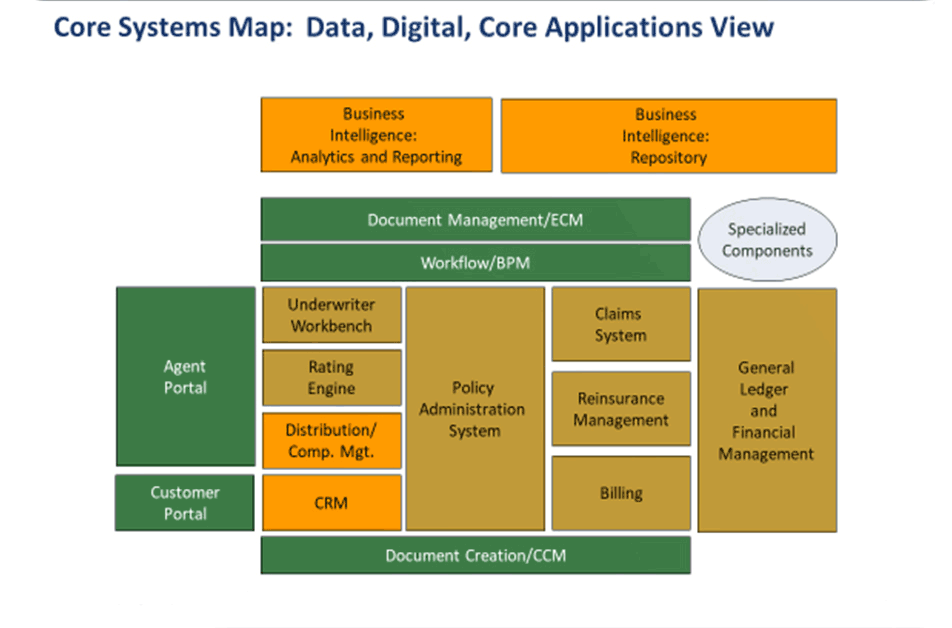At the 11th Annual Novarica Insurance Technology Research Council meeting, two keynotes laid out some fundamental issues for the industry to address.
Novarica Keynote: Key Insurance and Technology Trends for 2018 and Beyond
If I had to pick out a single dominant theme of my presentation on Novarica’s recent research and guidance to clients, it would be
realignment. Rapid changes in technology capabilities are opening the door to realignment of the insurance value chain and product itself, as well as insurers' technology stacks, and the management of technology organizations within insurers.
Realignment of the Value Chain and Product. We’ve been talking for the past few years about how advances in information technology make it easier than ever to analyze, package and transfer risk. Each of the traditional participants in the value chain between individuals or companies and the capital markets (i.e., distributors, primaries and reinsurers) is under immense pressure to prove added value and avoid disintermediation. We’re also seeing insurers start to leverage their risk management knowledge into products beyond loss reimbursement, with companies like Allstate commercializing their telematics capabilities and even selling their roadside assistance capabilities on a fee basis through partnerships.
See also: 9 Key Questions for Insurer IT Leaders
Realignment of the Technology Stack. While insurers continue to strive for advantage in data and digital, and to build a solid foundation for agility and evolution by replacing legacy core systems, we’re starting to see two major changes. The first, which is more pronounced, is the incredible growth of cloud computing. Our research has shown a major shift in acceptance and embrace of cloud, and several meeting participants told us they plan to be 100% cloud-based within two years. The second, which is still at an earlier stage, is the embrace of microservices architectures, and the adoption of a capabilities-level architecture rather than an application-level architecture. This is something we’ll be watching closely in the next few years.
 Realignment of the Technology Organization.
Realignment of the Technology Organization. All business units are more dependent on technology than ever before, and the widespread adoption of agile is helping to improve communications, relationships and collaboration between IT and other business units in many ways. But there’s still a fundamental disconnect in many companies between the way that IT evaluates its own performance and the way that other business units evaluate IT’s contribution to achieving the company’s goals. We published research this year on the benefits of using business KPIs and IT value metrics, to ensure shared understanding and the feeling of shared values between IT and other business units.
I closed with
our nine questions for insurer IT leaders, all of which encourage re-evaluation of current practices and attitudes from an outside perspective. For example, instead of asking how to manage the threat of insurtech, ask what can be learned from these new entrants that are approaching the industry with a fresh point of view. Instead of asking how to win the war for talent, ask what is the value of working at your company? And instead of asking how to justify an IT investment, ask, how does the IT capability drive business results?
Guest Keynote: Scaling and Growing High-Performance Organizations

Chris Yeh has founded, invested in or advised more than 50 high-tech startups. He is the co-author, with LinkedIn founder Reid Hoffman, of
The Alliance: Managing Talent in the Networked Age and the forthcoming
Blitzscaling, based on a class he team-taught with Hoffman and others at Stanford. His presentation covered material from both works. If I had to pick out a single theme from his keynote, it would be clarity.
Blitzscaling, the ability to grow an enterprise quickly, requires a clear understanding of the goals and risks. It’s defined as: “The pursuit of rapid growth by prioritizing speed over efficiency in the face of uncertainty.” This is a conscious choice to do things in a particular way that might be viewed as “wrong” by other frameworks but makes perfect sense when viewed against the Blitzscaling opportunity.
The clarity of the strategic decision cuts through the noise of demands for efficiency. While insurers may not have many opportunities to Blitzscale, having this same level of clarity around goals to insulate them from traditional operational demands is critical to the ability to drive innovation.
See also: How Technology Drives a ‘New Normal’
The Alliance framework for talent acquisition and management has a similar level of clarity to it. Companies and the people they need each have diverse objectives, some of which align and some of which do not. However, most talent strategies don’t acknowledge this, and are built on a level of disingenuity on both sides. By starting from a clear-eyed assumption that the employee is building a career that may involve leaving the company at some point, both parties can focus on creating mutual value and growth during the period of their alliance.
As one CIO commented to me later, “Chris talking about looking at your employees as having ‘tours of duty’ and how we as leaders need to look at how we help them ‘level up’ was very relevant to some actual personnel situations I’m dealing with.”
 Realignment of the Technology Organization. All business units are more dependent on technology than ever before, and the widespread adoption of agile is helping to improve communications, relationships and collaboration between IT and other business units in many ways. But there’s still a fundamental disconnect in many companies between the way that IT evaluates its own performance and the way that other business units evaluate IT’s contribution to achieving the company’s goals. We published research this year on the benefits of using business KPIs and IT value metrics, to ensure shared understanding and the feeling of shared values between IT and other business units.
I closed with our nine questions for insurer IT leaders, all of which encourage re-evaluation of current practices and attitudes from an outside perspective. For example, instead of asking how to manage the threat of insurtech, ask what can be learned from these new entrants that are approaching the industry with a fresh point of view. Instead of asking how to win the war for talent, ask what is the value of working at your company? And instead of asking how to justify an IT investment, ask, how does the IT capability drive business results?
Guest Keynote: Scaling and Growing High-Performance Organizations
Realignment of the Technology Organization. All business units are more dependent on technology than ever before, and the widespread adoption of agile is helping to improve communications, relationships and collaboration between IT and other business units in many ways. But there’s still a fundamental disconnect in many companies between the way that IT evaluates its own performance and the way that other business units evaluate IT’s contribution to achieving the company’s goals. We published research this year on the benefits of using business KPIs and IT value metrics, to ensure shared understanding and the feeling of shared values between IT and other business units.
I closed with our nine questions for insurer IT leaders, all of which encourage re-evaluation of current practices and attitudes from an outside perspective. For example, instead of asking how to manage the threat of insurtech, ask what can be learned from these new entrants that are approaching the industry with a fresh point of view. Instead of asking how to win the war for talent, ask what is the value of working at your company? And instead of asking how to justify an IT investment, ask, how does the IT capability drive business results?
Guest Keynote: Scaling and Growing High-Performance Organizations
 Chris Yeh has founded, invested in or advised more than 50 high-tech startups. He is the co-author, with LinkedIn founder Reid Hoffman, of The Alliance: Managing Talent in the Networked Age and the forthcoming Blitzscaling, based on a class he team-taught with Hoffman and others at Stanford. His presentation covered material from both works. If I had to pick out a single theme from his keynote, it would be clarity.
Blitzscaling, the ability to grow an enterprise quickly, requires a clear understanding of the goals and risks. It’s defined as: “The pursuit of rapid growth by prioritizing speed over efficiency in the face of uncertainty.” This is a conscious choice to do things in a particular way that might be viewed as “wrong” by other frameworks but makes perfect sense when viewed against the Blitzscaling opportunity.
The clarity of the strategic decision cuts through the noise of demands for efficiency. While insurers may not have many opportunities to Blitzscale, having this same level of clarity around goals to insulate them from traditional operational demands is critical to the ability to drive innovation.
See also: How Technology Drives a ‘New Normal’
The Alliance framework for talent acquisition and management has a similar level of clarity to it. Companies and the people they need each have diverse objectives, some of which align and some of which do not. However, most talent strategies don’t acknowledge this, and are built on a level of disingenuity on both sides. By starting from a clear-eyed assumption that the employee is building a career that may involve leaving the company at some point, both parties can focus on creating mutual value and growth during the period of their alliance.
As one CIO commented to me later, “Chris talking about looking at your employees as having ‘tours of duty’ and how we as leaders need to look at how we help them ‘level up’ was very relevant to some actual personnel situations I’m dealing with.”
Chris Yeh has founded, invested in or advised more than 50 high-tech startups. He is the co-author, with LinkedIn founder Reid Hoffman, of The Alliance: Managing Talent in the Networked Age and the forthcoming Blitzscaling, based on a class he team-taught with Hoffman and others at Stanford. His presentation covered material from both works. If I had to pick out a single theme from his keynote, it would be clarity.
Blitzscaling, the ability to grow an enterprise quickly, requires a clear understanding of the goals and risks. It’s defined as: “The pursuit of rapid growth by prioritizing speed over efficiency in the face of uncertainty.” This is a conscious choice to do things in a particular way that might be viewed as “wrong” by other frameworks but makes perfect sense when viewed against the Blitzscaling opportunity.
The clarity of the strategic decision cuts through the noise of demands for efficiency. While insurers may not have many opportunities to Blitzscale, having this same level of clarity around goals to insulate them from traditional operational demands is critical to the ability to drive innovation.
See also: How Technology Drives a ‘New Normal’
The Alliance framework for talent acquisition and management has a similar level of clarity to it. Companies and the people they need each have diverse objectives, some of which align and some of which do not. However, most talent strategies don’t acknowledge this, and are built on a level of disingenuity on both sides. By starting from a clear-eyed assumption that the employee is building a career that may involve leaving the company at some point, both parties can focus on creating mutual value and growth during the period of their alliance.
As one CIO commented to me later, “Chris talking about looking at your employees as having ‘tours of duty’ and how we as leaders need to look at how we help them ‘level up’ was very relevant to some actual personnel situations I’m dealing with.”







